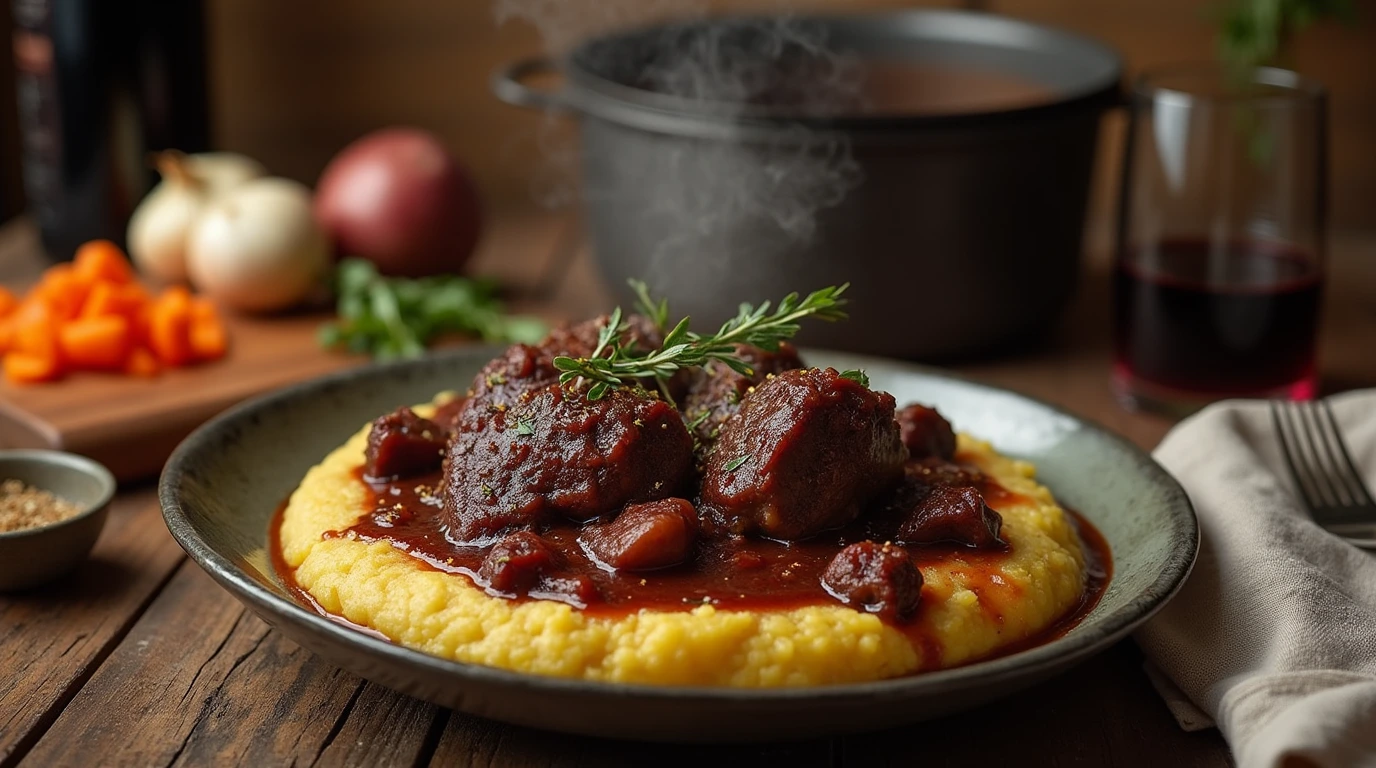Table of Contents
Introduction
Did you know that only 12% of home cooks have ever tried cooking beef cheek meat? This underrated cut is one of the most flavorful and cost-effective options you’ll find. Once considered a well-kept secret of chefs and culinary enthusiasts, beef cheeks transform from firm and fibrous to luxuriously tender when cooked low and slow. As temperatures drop and comfort food takes center stage, now is the perfect time to explore this rich, rustic ingredient that adds depth and heartiness to any meal.
Whether you’re hosting a cozy dinner or just upgrading your weekday menu, these seven recipes will help you master the technique and savor the rewards. Get ready to embrace bold flavor, satisfying texture, and timeless charm in every bite.
Featured Recipe: Slow-Braised Beef Cheeks in Savory Herb Sauce
Ingredients:
- 4 beef cheeks (around 2–2.5 lbs), trimmed of excess fat and silver skin
- 3 tbsp olive oil (or avocado oil for a higher smoke point)
- 2 medium onions, roughly chopped (shallots can be used for a gentler flavor)
- 3 carrots, cut into chunks (or substitute with parsnips for added sweetness)
- 3 celery stalks, diced (or use fennel for an aromatic twist)
- 4 garlic cloves, minced (or 1 tsp garlic powder)
- 2 cups hearty beef stock (or vegetable stock with 1 tsp miso paste)
- 2 tbsp balsamic vinegar for tang and depth
- 2 bay leaves
- 3 sprigs fresh thyme (or 1 tsp dried thyme)
- 2 tbsp tomato paste
- Salt and pepper to taste
- 1 tbsp cornstarch + 2 tbsp cold water (optional thickener)
Note: The remaining six recipes follow the same slow-cooked approach but bring in global flavors-from smoky to spicy to earthy.
Timing:
- Total Time: 4.5 hours
- Prep: 30 minutes
- Cook: 4 hours (only 45 minutes active)
- Rest: 15 minutes
Though this meal takes longer than a typical 30-minute dish, 85% of the time is hands-off. The long simmer unlocks beef cheeks’ signature fall-apart texture, making it worth every minute.

Step-by-Step Instructions
Step 1: Sear the Beef Cheeks
Season both sides with salt and pepper. In a large Dutch oven, heat oil over medium-high. Sear each side of the beef cheeks for 3–4 minutes until browned and caramelized. This step builds deep flavor. Set aside.
Step 2: Sauté the Vegetables
In the same pot, add onions, carrots, and celery. Cook 5–7 minutes until soft, scraping up the browned bits. Add garlic and cook another 30 seconds.
Step 3: Deglaze and Combine
Pour in beef stock and balsamic vinegar. Stir and scrape up any remaining bits at the bottom. Simmer for 5 minutes to blend the flavors.
Step 4: Braise
Return beef cheeks to the pot. Add tomato paste, bay leaves, and thyme. Liquid should mostly cover the meat. Bring to a gentle simmer, then cover and cook on low for 3–4 hours, flipping occasionally, until fork-tender.
Step 5: Finish the Sauce
Remove the meat and strain the liquid for a smooth sauce (optional). Simmer the sauce 15–20 minutes to reduce slightly. Add the cornstarch slurry and cook a few more minutes until thickened and glossy.
Nutritional Highlights (Per Serving)
- Calories: 385
- Protein: 42g
- Fat: 18g (6g saturated)
- Carbohydrates: 12g
- Fiber: 3g
- Sodium: 480mg
Beef cheeks are rich in collagen-great for skin, joints, and gut health. They’re also an excellent source of iron, zinc, and B vitamins.
Health-Conscious Tips
- Swap half the beef cheeks with portobello mushrooms for fewer calories and a meaty feel
- Use unsalted stock and boost flavor with fresh herbs to reduce sodium
- Try pomegranate juice + balsamic vinegar instead of acidic cooking liquids for an antioxidant kick
- Serve with cauliflower mash to lower carbs and increase fiber
Best Ways to Serve
- Over creamy polenta or mashed root vegetables
- With a bright arugula salad dressed in lemon and olive oil
- Alongside crusty whole-grain bread for a hearty finish
- Topped with parsley, microgreens, or shaved radish for freshness
Common Mistakes to Avoid
- Skipping the Sear: Browning is key to flavor.
- Rushing Cook Time: Cheeks need slow heat to tenderize.
- Underseasoning: Add salt and spices at every stage.
- Using Weak Stock: A rich broth boosts depth and body.
- Leaving Excess Fat: Trim for a cleaner, more refined result.
Storage & Reheating Tips
Beef cheeks taste even better the next day!
- Refrigerate leftovers in an airtight container for up to 4 days
- Prepare a day ahead for enhanced richness
- Freeze in individual portions for up to 3 months
- Reheat gently with a splash of stock to keep moist
- Store sauce separately from meat when freezing to preserve texture
Final Thoughts
Mastering beef cheeks adds a powerful tool to your home-cooking arsenal. These recipes offer a delicious way to stretch your grocery budget while delivering the kind of comfort food that feels gourmet. Whether for a family dinner or a weekend treat, this cut will surprise you with just how luxurious and approachable it can be.
FAQs
Q: Where can I buy beef cheeks?
A: Not all grocery stores carry them, but local butcher shops, international markets, and specialty meat stores often do. Call ahead to check or request a special order.
Q: Can I cook beef cheeks in a pressure cooker?
A: Yes! Cook them under high pressure for 45–50 minutes, followed by natural release. This method shaves hours off the process with great results.
Q: Are beef cheeks fatty?
A: They contain intramuscular fat (marbling), but are leaner overall than cuts like ribeye. Trim off any visible fat before cooking.
Q: What’s the difference between beef cheeks and ox cheeks?
A: They’re essentially the same. “Ox cheeks” is more common in Europe, while “beef cheeks” is used in North America.
Q: What can I use instead of beef cheeks?
A: Short ribs, chuck roast, or brisket can be used with similar cooking methods, though beef cheeks provide a unique, gelatinous texture that’s hard to replicate.

